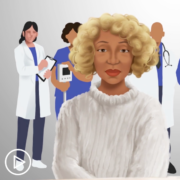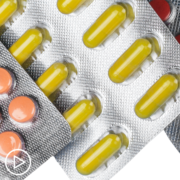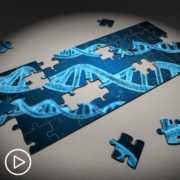AML Targeted Therapies, What’s Available and How Do They Work?
AML Targeted Therapies, What’s Available and How Do They Work? from Patient Empowerment Network on Vimeo.
There are several targeted therapies approved for the treatment of acute myeloid leukemia (AML). Expert Dr. Ellen Ritchie provides insight about recent approvals, how these therapies work, and shares details about newer therapies currently being studied for the treatment of AML.
Dr. Ellen K. Ritchie is assistant professor of medicine and a member of the Leukemia Program at the Weill Cornell Medical College of Cornell University and the New York Presbyterian Hospital. More about Dr. Ritchie, here.
Related Resources:

|

|
Transcript:
Katherine:
You touched upon this earlier, but what targeted therapies or treatments are available for AML patients?
Dr. Ritchie:
So, there have been many recent FDA approvals of drugs that are targeted. One, is the FLT3 inhibitors. And the two that are available are Midostaurin, which is most commonly – was the first drug that was really added to intensive chemotherapy.
And clinical trials show that in those FLT3-positive population that patients had an overall better outcome if midostaurin (Rydapt) were added to intensive chemotherapy. There’s also a drug called gilteritinib (Xospata), and this drug is also a FLT3 inhibitor that was tested in patients who had refractory leukemia. They could either get real chemotherapy regimen or they could get gilteritinib. And it turns out in the FLT3-positive patients, the gilteritinib was superior to the strong chemotherapy. So that’s been approved for patients who have refractory, or disease that didn’t really respond to initial therapy, that is IDH – or is FLT3-positive.
Then there’s the IDH1 and IDH2 inhibitors that have also been approved, and a small proportion of AML patients will be positive for IDH1 or IDH2 mutations.
The IDH1 inhibitor ivosidenib (Tibsovo), is available and can be used to treat patients if you know up front, they have an IDH1 inhibitor. So, that’s a regimen where the single agent can be used to treat an IDH1 mutated patient who’s newly diagnosed. Those patients are also eligible for many clinical trials now, where they’re combining that particular drug with other agents, in an effort to improve outcome. For IDH2 positive patients, there’s a drug called enasidenib (Idhifa). And this drug is used mainly in patients in the second line setting. But it specifically targets IDH2. And patients go into remission sometimes for a prolonged period of time. So, these drugs are FDA approved, and they’re treating targetable mutations.
TP53 mutations are a particularly bothersome mutation because it confers a poor outcome. And I’m happy to say that we have clinical trials now that are available that actually target TP53 mutations.
So, there are – there is therapy available for that type of mutation that was
not available before through the clinical trials. And I expect in coming years that we’re going to see more and more targeted therapies develop in AML which can be used potentially in combination with what we’re already using as backbones to enhance the outcome of patients with this disease.
Katherine:
Well, how do targeted therapies work?
Dr. Ritchie:
So, targeted therapies work on – it’s sort of complicated. The targets which are available, IDH or the FLT3 is really on the outside of the cell and it is a drug which is targeted directly to the FLT3 on the outside of the cell.
It works quite well in the peripheral blood, where you see the blast oftentimes disappear. The big concern always is how well it’s working getting deep into the marrow. But it’s looking at the target on the outside of the cell. IDH1 and IDH2 inhibitors work on particular chemicals which are involved in the kreb cycle, and those of you that took high school chemistry may have memories buried in the deep parts of your brain of learning the kreb cycle. And this is a fundamental metabolic cycle inside cells, and if you have a mutation, an IDH1 or IDH2, you’re unable to go through that full kreb cycle in the appropriate way. And that is something that leads to you having a cancer, in this case AML. So, these drugs actually interfere with what’s happening in that kreb cycle, and allow you to make more normal cells.











